
Tax benefits are icing on the philanthropy cake. What to do when the icing is melting?
Tax benefits are icing on the philanthropy cake. What to do when the icing is melting?
First, the good news.
The sky is not falling.
Human beings have given long before the existence of charitable deductions. Human beings are generous. They like being helpful. They like making a difference. They like doing the right thing.
Philanthropy helps people fulfill their higher purpose. It gives them meaning.
The primary reason people give is not to get a tax deduction.
It’s to see themselves reflected in a mirror as the person, deep down, they really want to be.
Now, the bad news.
If you’ve been relying on using language about tax deductibility of gifts to inspire people to give, you must revise your strategy in light of the new Tax Law.
Hmmn… maybe that’s actually not such bad news.
Because the most passionate philanthropy stems from deeply held values. People who make major gifts, and who give to you repeatedly, do so regardless of the economy. They stick with you through thick and thin. Because… they believe.
So… wouldn’t it be much better to focus on turning them into believers? To anchor your appeals by telling people value-laden stories that inspire them to jump into the narrative and become the hero?
In my experience, tax benefits are icing on the cake. Most donor heroes still want the cake, iced or not.
Still… a little icing never hurt. Let’s look at some ways you can give donors a little extra push to buy your particular cake in the newly-revised tax landscape.
8 Nonprofit Tips for Dealing with the New Tax Law
1. Rich Donors Will Have More After-Tax Dollars to Spend
There’s never been a better time to focus on major donor fundraising.
Of course, it’s always been a good idea given that over 88% of all funds raised come from just 12% of donors. With the new tax law, this proportion could dramatically change so the lion’s share of philanthropy comes from an even smaller slice of donors at the top.
When you talk to your major donor prospects this year, how about asking them how they intend to spend their after-tax windfall? Get them thinking about the fact they’ve just been given a gift worth more than the value of their past tax deductions. Net/net, they won’t come out worse this year if they repeat or increase their gift to you. The more flush donors feel, the more likely they are to spend their wealth – philanthropically or otherwise.
It’s worth noting the government has just made a huge statement about its role in funding the social benefit sector.
They’re abdicating. That means the onus falls more and more to socially-conscious philanthropists.
Make your donors feel they’re the ‘good guys.’
2. Those Who Itemize Can Now Deduct More
The limit for deductions has been increased from 50% to 60% of Adjusted Gross Income (AGI).
Though this may apply to only about 5% of taxpayers, for those major donors to whom it’s applicable it’s a reason to donate more (and have it cost less).
Your charity can remind folks of these changes. You can also ask donors if they have a Donor Advised Fund (DAF), which has long been a convenient vehicle for major donors who have windfalls in particular years and want to avoid losing a huge chunk of their gain to taxes. You can suggest to folks they might want to ‘bunch’ their donations by consolidating the equivalent of two to three years’ worth of giving into one gift to a DAF They’ll get a large tax deduction that year, and can recommend distributions from their DAF to your charity (and others) over the ensuing years.
3. Pay Extra Attention to Mid-Level Donors
This is where, if you do nothing differently, you could see donations diminish.
The new tax law increases the standard deduction, effectively shielding the first $24,000 of household income (for couples) from taxes. This will likely dramatically reduce the number of American families who itemize deductions for breaks on things such as medical bills, mortgage interest and charitable deductions. According to Una Osili, professor of economics and associate dean for research and international programs at the Indiana University Lilly Family School of Philanthropy, roughly 30 million households making between $50,000 and $100,000 will be less likely to itemize their deductions. The Tax Policy Center notes roughly 35% of households previously itemized; moving forward, only 5 – 10% will itemize. They estimate this change will reduce charitable giving by up to $20 billion a year.
Why? Non-itemizers are less incented to give to charity. A study by the Lilly School found itemizers are much more likely to donate to charitable causes: “83 percent of itemizers reported donating any amount of charitable giving at all, compared to 44 percent of non-itemizers. In fact, non-itemizers contribute less than 20 percent of total giving.”
Suffice it to say many of your mid-level donors may not exactly be feeling the love.
This is where your opening lies. Now, more than ever, you have an opportunity to show them some love. So double down; treat your donors like royalty. All of them, not just the big donors.
4. Understand and Tap Into Why Donors Give
Moral or religious obligation can be a prime mover.
Organizations most likely to suffer from the tax changes are local charities, congregations and basic needs organizations. The arts and education, traditionally favored by wealthier donors, may be less impacted.
A report by Giving USA on religious giving found that “62 percent of religious households give to charity of any kind, compared with 46 percent of households with no religious affiliation.”
Do all you can to understand what your donors value. Ask them in person. Conduct surveys. Observe which articles they open and read, and which stories they like and retweet. Match their values to yours in your donor communications.
5. Take Advantage of New Corporate Giving Opportunities
Just like major individual donors, many businesses will see a cash windfall from the new tax law.
Talk to businesses you know and ask them how they expect to spend these extra dollars. Some large companies have already announced wage increases and bonuses, though others see these as a mere publicity stunt. Either way, what better time for you to begin a discussion about how giving to your cause could generate even greater goodwill?
6. Reach Out to Foundations Benefitting from the Robust Stock Market
Many foundations are seeing their investments grow.
Some of them never really returned to pre-recession giving levels, and the current economy may mean they’ll have more grantmaking power in the coming year. Talk to them!
7. Change Your Legacy Giving Marketing Approach
Talk with supporters about how they want to see their values live on, rather than how a bequest can save them tax payments.
The new law more than doubles the size of estates that will be subject to the federal estate tax, to over $22 million. This means fewer families will be subject to this tax. And this means fewer families will be looking for ways to avoid it.
The bad news for charities is the estate tax has been shown to be a strong incentive for super-wealthy to give to charity rather than pay the tax. I used to tell donors subject to this tax they had three choices of where to leave their money when they died: (1) family; (2) government, and (3) charity. The kicker? They had to pick at least two. Many preferred the option of family + charity to the option of family +government.
Eliminating this inevitable choice for many more estates will cause a substantial decline in very large gifts: the kind that can be truly transformational for charities, colleges, hospitals and the arts. The best evidence for this comes from 2010 when the estate tax was not in force for one year: charitable bequests dropped by 37 % from the previous year, and then rose by 92% in the following year when the estate tax was restored.
Don’t forget, however, that if your donor has no heirs they still have a bilateral choice: (1) government; (2) charity. They may prefer their assets pass to charity rather than to the government.
8. Advocate for Beneficiaries
The folks who rely on you to fulfill your mission will need to rely on you more than ever. It won’t be the first time nonprofits have faced slashes in government appropriations, and it won’t be the last. Right now the majority in Congress are pushing for continued reductions in community development block grants and deep cuts to social safety net programs to make up for deficits resulting from recent tax cuts. Rally your troops, and get ready to make your opinions known! Invite your representatives to see your work in action, and help them to look like good guys to their constituents when they support you.
NEW TAX LAW BOTTOM LINE:
Whatever you do, don’t buy into the negative publicity and use it as an excuse for failure. Focus on what’s within your control (solid fundraising), not what’s outside your control (tax legislation). Failure may be an option, but truly it’s a lousy choice. Especially when you have so many better options!
1. Ramp up major gift fundraising.
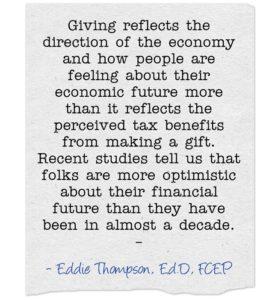 It’s always given charities the biggest bang for the buck. Moving forward, this will be truer than ever. Turn lemons into lemonade by taking this opportunity to enroll in my upcoming 8-week Winning Major Gifts Strategies e-course. You’ll learn everything you need to know to set up (or accelerate) a strong major gift program. With the reduced incentive to give for small and mid-level donors, it makes total sense to focus efforts on wealthier donors. If you’re not making many face-to-face visits and asks, you need to start.
It’s always given charities the biggest bang for the buck. Moving forward, this will be truer than ever. Turn lemons into lemonade by taking this opportunity to enroll in my upcoming 8-week Winning Major Gifts Strategies e-course. You’ll learn everything you need to know to set up (or accelerate) a strong major gift program. With the reduced incentive to give for small and mid-level donors, it makes total sense to focus efforts on wealthier donors. If you’re not making many face-to-face visits and asks, you need to start.
NOTE: A great way to ramp up in this area is to enroll in in my Winning Major Gifts Strategies e-course. Learn more about this at the bottom of this article.
2. Communicate more effectively with mid-level donors.
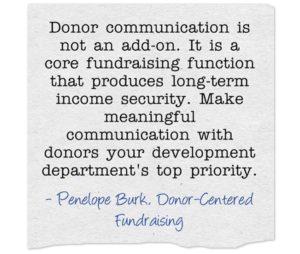 Groundbreaking donor-centered research by Penelope Burk revealed how vital donor communications are to retention and upgrading. The core of this work is that 93% of donors would definitely or probably give again if we communicated with them more effectively, 74% would continue giving; 64% would give more. All they want is a few things: (1) prompt, personal acknowledgment; (2) indication their gift is being used for intended purposes, and (3) some additional communication about the gift’s impact. Tax deductions are not high on the list. They’re a reason, but only a good one if you give them no other good reasons. So… work a little harder to make a good impression.
Groundbreaking donor-centered research by Penelope Burk revealed how vital donor communications are to retention and upgrading. The core of this work is that 93% of donors would definitely or probably give again if we communicated with them more effectively, 74% would continue giving; 64% would give more. All they want is a few things: (1) prompt, personal acknowledgment; (2) indication their gift is being used for intended purposes, and (3) some additional communication about the gift’s impact. Tax deductions are not high on the list. They’re a reason, but only a good one if you give them no other good reasons. So… work a little harder to make a good impression.
3. Make 2018 all about donor love and donor experience, not about you.
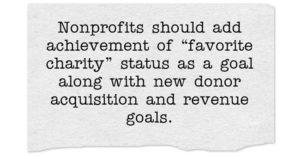 A study by NTEN and Charity Dynamics found a donor’s charitable attention may be distributed across multiple causes, but they are likely to give a greater portion of their annual giving to a single charity with which they feel most connected. The more donor-centered you can become, the better your results will be.
A study by NTEN and Charity Dynamics found a donor’s charitable attention may be distributed across multiple causes, but they are likely to give a greater portion of their annual giving to a single charity with which they feel most connected. The more donor-centered you can become, the better your results will be.
4. Reach out to businesses and foundations doing well in the current environment.
 It always makes sense to diversify your sources of income. If businesses and foundations have turned you down in the past, now may be an opportune time to revisit them.
It always makes sense to diversify your sources of income. If businesses and foundations have turned you down in the past, now may be an opportune time to revisit them.
5. Make legacy giving about values, not tax benefits.
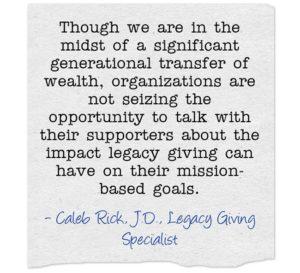 Planned gifts will come from those with whom you’ve communicated effectively and who love the values you enact. Essentially, they’ll be members of your family who would no more leave you out of their estate planning than they would their own children. Regardless of the tax benefits (or lack thereof). People will tend not to leave legacy gifts unless you ask them to. Now’s the time to master the fundamentals and develop an intentional planned giving program.
Planned gifts will come from those with whom you’ve communicated effectively and who love the values you enact. Essentially, they’ll be members of your family who would no more leave you out of their estate planning than they would their own children. Regardless of the tax benefits (or lack thereof). People will tend not to leave legacy gifts unless you ask them to. Now’s the time to master the fundamentals and develop an intentional planned giving program.
6. Become a better advocate.
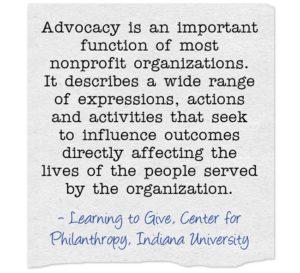 This tax law was written in haste. There are unintended consequences. Your organization has the ability, and the responsibility, to make your voice heard.
This tax law was written in haste. There are unintended consequences. Your organization has the ability, and the responsibility, to make your voice heard.
Advocacy helps your nonprofit, and those who rely on you, survive and thrive.
7. If you still want to talk to donors about tax benefits…
 Some of the biggest tax advantages for donations were left untouched. So you can still be smart and helpful by reminding donors:
Some of the biggest tax advantages for donations were left untouched. So you can still be smart and helpful by reminding donors:
- They can donate appreciated stocks, bonds, or other assets and avoid paying capital gains taxes on the appreciation — regardless of whether or not they itemize. Encourage them to simply take the cash they would have donated and use it to immediately buy identical stocks, bonds, or other assets to replace the donated ones. Their investment portfolio won’t change; the “new” asset now has a 100% basis, meaning that no capital gains taxes will be paid on any past appreciation. This is a big win for your donor, but also for your charity because the donor is now thinking about gifts from assets (i.e., “the big bucket”) rather than simply gifts from monthly disposable income (i.e., “the little bucket”).
- They can give to you out of a donor advised fund. Ask your donors if they have one, in which case they may have bunched donations for 2017 and 2018 (and beyond) into a single large gift, and there may be money waiting to be distributed. You might also want to consider setting up your own DAF program.
- Donors age 70 ½ or older receive a tax advantage when they donate directly from an IRA. This qualified charitable distribution is better than a deduction because the income is excluded from the donor’s income (keeping many donors in lower tax brackets) and the gift counts towards their required minimum distribution. This tax benefit is the same whether or not the donor itemizes.
Charities may have to rework how they pitch their appeals to donors… I think what it will do is cause charities to sharpen their fundraising efforts. They’ll need more sophisticated fundraising techniques.” – Marcus Owens, Partner, Loeb & Loeb law firm
Winning Major Gifts Registration Closes January 20th

You can’t afford not to ask for major gifts. They’re the most cost-effective way to fundraise. Registration closes January 20th.
Enroll yourself and your team (up to six people per organization) in my Winning Major Gifts Strategies e-course. I offer it just once a year, and the 2018 course begins January 23rd. Grab your spot NOW to catch the BIG ‘early bird’ bargain before it flies away January 5th. I hope you’ll take a minute to review the curriculum and see what your peers had to say about the course.
If you’re a Clairification School member, grab your discounted enrollment HERE.
If you haven’t joined this year as a paid Clairification School student, now’s the perfect time to do so! You’ll more than make up your fee by the $200 discount you’ll receive on the 8-week E-Course. You can enroll and get the e-course discount with one click HERE.






This article is deficient on motivations of folks who donate and earn less than the Median Family Income. Removing this incentive for those making less is an issue. Making giving an elite activity is ugly at best. There are limited numbers of folks with large annual incomes and more need than can be accommodated.
Agree in the best of all possible worlds, in terms of social policy, the charitable deduction would be extended to everyone — regardless of other available deductions. Also agree that because the standard deduction ceiling has been raised, more folks who are at medium incomes will select this option. This may disincent them to give, because the out-of-pocket cost to do so will be higher. This assumes, however, that the primary motivator for giving is to get a tax deduction. Research shows this is generally not the case. We will have to see what transpires. One thing is clear: Nonprofits need to do a more effective job selling the IMPACT of philanthropy, and what would happen if their organization ceased to exist. Thanks for commenting. 🙂
I don’t believe or assume the tax incentive is the ONLY reason folks with less give but, as a fundraiser for more than 20 years, folks always want their tax letter. That says something. We will be conducting a donor motivation survey of our 40,000 donors, most of whom give $250 or less. This will include how and if their donation will change.
Saying nonprofits need to show better IMPACT assumes leaders are not doing this already and offers a criticism that casts a poor light on the industry. Showing impact costs money and to the extent possible (affordable) there are some pretty great causes telling their story all day. But, helping a family out of houselessness (or whatever your mission) is why we are here. We will continue to do both but direct service will always be the first choice in spending.
As leadership turns folks away from a charitable perspective, welfare reform is on the horizon. The war on the poor is about to hit high gear. We need all the incentives to shore up communities until compassion returns to the Whitehouse.
Michael, thank you for this perspective. I have no real argument with what you say. My point is really that we’ve been given lemons, and need to make some lemonade. Being unhappy with a law is one thing.
Adapting to its ramifications in order to best continue to fulfill one’s mission is another. Significant challenges will be presented by the new federal tax laws, which remove many traditional incentives for giving – especially to smaller and local nonprofits, as you point out. At the same time, some folks will have windfalls and we should talk to those people. There is also a trend towards issue-related giving and impact investing, hence the admonition to stress impact over tax deductibility. And, sadly, not every nonprofit does an effective job in this regard. I’m not suggesting every nonprofit go on TV with long video presentations. I’m suggesting a reasonable, strategic storytelling approach using all available communication channels .(in-person, mail, email, website, social media). The good fight continues on all fronts.
Loved this helpful article. It reassured me that the relationship is more important than the tax deduction.
It truly is. We give gifts to our friends and family without the promise of a tax deduction in return. The same is true for political candidates. It’s because we love them and believe in them. Folks who love and believe in causes do the same.
We people have given long before the existence of charitable deductions, and we people are generous we like being helpful, we like making a difference, we like doing the right thing.